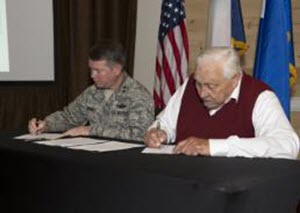Story by: Capt. Martha Nigrelle
Posted: June 8, 2015
 Capt. Martha Nigrelle
Capt. Martha Nigrelle
Maj. Gen. John F. Nichols, adjutant general of Texas, left, and Charles Coleman, Thlopthlocco Tribal Town, right, sign letters of understanding during an annual tribal consultation conference to discuss the preservation and protection of historic resources located on Texas military lands, May 19-20, 2015, in Austin, Texas. The Texas Military Forces work one-on-one with tribes who trace their historic roots to Texas, for any period of time, in an effort to record both Texas military history and Texas tribal history for future generations. (Texas National Guard photo by Army Capt. Martha Nigrelle/Released)
AUSTIN, Texas - Members of the Texas Military Forces gathered with representatives of seven Native American tribes in an annual tribal consultation conference to discuss the preservation and protection of historic resources located on Texas military lands, May 19-20, 2015 in Austin.
The Texas Military Forces work one-on-one with tribes who trace their historic roots to Texas, for any period of time, in an effort to record both Texas military history and Texas tribal history for future generations.
“We have to maintain the history of the place that we live,” said Maj. Gen. John F. Nichols, the adjutant general of Texas. “We are a part of this history. By preserving Texas history, we preserve our history too.”
The Texas Military Forces operates five training sites across the state, covering approximately 30,000 acres of land. These 30,000 acres have had numerous residents in the past 8,000 years – different tribes, different people and now, the Texas Guard. It is this fact that forged a unique relationship between the military and a diverse group of Native American tribes.
In the 1990s, the Texas military began consulting with Tribal representatives in order to identify artifacts and locations of significance.
Today, representatives from the Alabama-Coushatta Tribe, Caddo Tribe, Comanche Nation, Coushatta Tribe of Louisiana, Alabama-Quassarte Tribal Town, Thlopthlocco Tribal Town, Kiowa Tribe, Mescalero Apache Tribe, Tonkawa Tribe, Wichita and Affiliated Tribes and the Apache Tribe of Oklahoma regularly meet with Texas military officials to discuss efforts being made to preserve both their heritage and ancient Texas history.
It’s a partnership that has forged a mutual respect and friendship.
“When they come to visit the tribes, they learn tribal traditions and tribal customs – this makes the relationship good,” said Charles Coleman, Thlopthlocco tribal representative and a recognized elder amongst the group, speaking of the guardsmen and Texas Military Forces representatives he works with one on one. “It all boils down to the personal relationships – them learning from us, us learning from them.”
This year’s conference opened when Nichols welcomed tribal representatives back to Austin and Coleman presented Nichols with a gift from his tribe, thanking Nichols for the efforts the Texas military takes in understanding Texan tribal history.
“It’s important to us, because it’s important to you,” said Nichols.
The conference continued with presentations from both the military and the tribal representatives present, focusing on upcoming renovations scheduled for training sites, current archaeological projects, improving access to artifacts and records from the military for tribal representatives and addressing any concerns on ways to improve the partnership and the preservation process.
During this time, training site commanders were recognized for their dedication to each training area.
“That’s their little piece of heaven and they want to take care of it,” said Lt. Col. Jamey Creek, commander, Training Centers Garrison Command, Texas Military Forces. “We want our training sites sustainable for many years.”
Cultural sensitivity training is a part of what all service members using the training grounds must go through said Creek. This is to help ensure that historical artifacts and sites found on military training grounds are taken care of appropriately.
As this topic continued, Nichols recommended that future training plans incorporate tribal partners in the planning and development of these classes. This idea was met with enthusiasm from both groups as a possibility for the future.
“It’s nice to be able to pick up the phone and speak to someone who you know cares about your concerns,” said Coleman. “We can use our resources and the National Guard can use their resources. It’s important that we look at the same thing.”
As the conference drew to a close, old friends and new friends said their goodbyes and reflected on the ties that bind – preserving a shared history for future generations to learn from.
“Artifacts need to come out of the shed,” said Coleman, “And into the head of the youth of America."